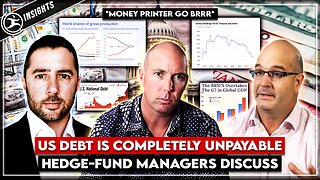Premium Only Content

Kandinsky: AGNSW resumes its Modern Masters series with the biggest exhibition
Kandinsky: AGNSW resumes its Modern Masters series with the biggest exhibition of the Modernist's work ever staged in Australia
An Emergency Warning has been issued for Nambeelup, North Dandalup, Myara and Kalamunda in Western Australia. For the latest, search on ABC Emergency
Get breaking news alerts directly to your phone with our app
Kandinsky: AGNSW resumes its Modern Masters series with the biggest exhibition of the Modernist's work ever staged in Australia
ABC Arts /
By Anna Freeland
Posted 12h ago12 hours ago, updated 9h ago9 hours ago
Kandinsky's Dominant Curve painting, featuring a tangle of abstract colourful shapes.
Vasily Kandinsky is one of the pioneers of Abstraction.(Supplied: Solomon R. Guggenheim Museum)
Help keep family & friends informed by sharing this article
Vasily Kandinsky had a spiritual relationship with colour.
Who was Vasily Kandinsky?
Kandinsky was a Russian avant-garde artist, working in the late 19th to mid-20th century.
He is best known for his abstract paintings, many of which were inspired by music.
It is speculated he had synesthesia and experienced colour as sound, and sound as colour.
He was a teacher at the famous Bauhaus school in Germany before it was closed by Nazis in the 30s.
He described it as a "living being" and a channel through which to reach the spiritual realm.
"Blue is the typical heavenly colour," he wrote in his 1912 manifesto Concerning the Spiritual in Art.
It was radical thinking for a Russian artist working in the early 20th century, whose predecessors favoured rationalism — and an aspect of Kandinsky's colour theory sometimes neglected by historians, averse to anything too "woo woo".
But that history, along with Kandinsky's place in the canon of Abstract art, is being revised.
The Art Gallery of New South Wales (AGNSW) has today opened its doors to a major retrospective of the modernist — its first in more than 40 years.
Boasting 53 works, it is the largest exhibition of Kandinsky ever mounted in Australia.
Kandinsky is best known for his abstract paintings. Recognisable by their swirling constellations of lines, splodges of colour and geometric shapes, his work is synonymous with the form, and has earned him the title "the pioneer of Abstract art".
Although that has been contested in recent years. More on this later.
The exhibition opens with several of the Moscow-born painter's earlier, Impressionist-inspired works — taken from the Solomon R. Guggenheim Museum in New York.
The museum has partnered with AGNSW and contributed 47 works to this retrospective, most of which have never been seen in Australia before. (None of Australia's major public galleries hold Kandinsky works.)
Boldly setting the tone at the exhibition's entrance is the vivid Blue Mountain, painted in 1908–09. Its namesake cobalt blue mountain is framed by bursts of crimson and ochre foliage. In the foreground is a sprightly assembly of horses and riders — a recurrent motif of Kandinsky's early works and a nod to his crusade against the Aesthetic movement of the late 19th century, which valued beauty over meaning. (Art for art's sake, as they say.)
Unlike the Aestheticists, Kandinsky believed in the transformative power of art, says Guggenheim's curator of modern art and provenance and the exhibition's co-curator, Megan Fontanella.
"These ideas of looking for deeper meaning or the 'hidden power of the palette', as [Kandinsky] calls it, is all very much a part of his practice," she told ABC RN's The Art Show.
"For Kandinsky, it's always about the emotive element, the psychological and spiritual effects of his art on the viewer."
Over six rooms, Kandinsky's artistic evolution plays out chronologically from his Impressionist experiments of the early 1900s, in works like Blue Mountain, through to his final years playing with biomorphic shapes (freeform and non-geometrical) in the mid-1940s.
"His artistic style evolved against the backdrop of the socio-political upheavals occurring around him," says Fontanella.
"But in the unwavering threads throughout Kandinsky his career, however, is his fervent belief in art's ability to transform self and society."
He wrote in his book Point and Line to Plane that art should be felt actively and "with all one's senses".
At age 30, he was famously inspired to abandon his career as an economics and law professor to pursue art after encountering Monet's Haystack series, later saying the artist's use of colour "surpassed [his] wildest dreams".
Kandinsky was particularly drawn to yellows and blues, often using them in contrast with each other: yellow was considered earthly and associated with human energy; blue was spiritual and represented infinity.
Fontanella says: "The colour yellow was this really loud, assertive, present colour. As you walk through an exhibition like this one … that yellow presents itself again and again, and it feels like the sound of the trumpet blast, hopeful and loud and present."
Kandinsky loved music (notably Wagner) and felt sound was inextricably linked to colour, which many historians believe could be attributed to undiagnosed synesthesia.
He described hearing flutes when he saw light blue, cellos for dark blue, a double bass for a richer dark blue and an organ for deep "serene" blue.
"Kandinsky was very interested in this idea of a multi-sensory experience that we could hear colour or see sound," says Fontanella.
"I see a musicality pulling throughout his work even as the language [and the location] changes. It shifts from those really vibrant jewel-box colours, to the geometry, to these more biomorphic forms … and you see it [and] feel it in different ways.
"The more you look at his canvases, you're rewarded for slow looking."
The birth of Abstraction
The exhibition is curated by the three primary chapters of Kandinsky's working life — roughly corresponding with his time spent in Russia, Germany and France — each with its own dominant artistic style.
Born in 1866, Kandinsky lived during a time of great upheaval in Western Europe. Sociopolitical ruptures, war and forced migration had a profound effect on his art
"I think Kandinsky's story, even 100 years later, feels very compelling. Here's an artist whose life and work is so much defined by these periodic upheavals [and] redefinitions of his life," says Fontanella.
"There's something in that story of resilience, adaptation [and] hope that feels deeply relevant to me today."
After discovering Monet's Haystacks in 1896, Kandinsky moved to Munich — then the epicentre of art-making in Germany — to study at the Munich Academy of Fine Arts. Kandinsky's early works were more Impressionist in style (as in Blue Mountain) and featured a bold chromatic palette depicting two-dimensional landscapes and Russian folkloric scenes.
One of the paintings from this period titled Murnau with Church II (1910) was sold at auction earlier this year for a record £37.2 million ($70.3 million). It was stolen from its Jewish owners by Nazis during World War II.
After graduating, Kandinsky began experimenting more seriously with abstraction, moving away from representational forms and motifs, like the horse and rider, the tower and rolling hills.
Fontanella says: "By 1913 [they] had really become subsidiary to line and colour and their expressive possibilities."
His first known abstract work was produced in 1913, Nothing Whatever to Do with an Object.
Experimentation through dislocation
With the outbreak of World War I, Kandinsky returned to Russia and became part of the Constructivist movement, an offshoot of the Russian avant-garde that reflected industrial society with austere geometric shapes.
Kandinsky continued experimenting with geometric shapes when he returned to Germany in 1921, amid the Russian Revolution. This time he settled in Weimar, where he took up a position teaching mural painting and analytical drawing at the Bauhaus school, alongside contemporaries Paul Klee, Josef Albers and László Moholy-Nagy.
During this period Kandinsky produced Composition 8, one of a series of 10 "compositions" inspired by music that the artist painted between 1910 and 1939. It's the work he was most proud of and features a dominant circle, a signature of Kandinsky's work in this period, representing the "cosmic realm".
The closure of the Bauhaus in 1933 at the behest of the Nazi party saw Kandinsky relocate yet again to the Parisian suburb of Neuilly-sur-Seine, which features in several of his later works.
The Nazis branded Kandinsky a "degenerate" in 1937 and ordered 57 of his paintings be removed from German museums — 14 were seized and displayed in Hitler's infamous exhibition Entartete Kunst (Degenerate Art).
In the final chapter of his life, Kandinsky became embedded in the Abstract and Surrealist art circles of Paris. He returned to his earlier interest in Russian and Siberian folklore around this time too, which he reimagined in the abstract.
"I actually find his late period in France deeply interesting … it feels like this accumulation of all these different experiences, cultural references, identity points, and also this sense of memory," says Fontanella.
"He writes that the light and the colours of Paris itself did affect his shift, yet again, in his artistic language, where we see this lightening of his palette, the pinks, the turquoises, purples, golds [start] coming to the fore."
His works in this period, such as Capricious forms (1937), feature whimsical biomorphic shapes, often floating dizzyingly adrift in space. On the surface, many of his works from the Paris period defy meaning but, to Kandinsky, they signified renewal and metamorphosis.
He remained in France until his death in 1944.
SHARE
News Ticker
BUSHFIRE WARNING
An Emergency Warning has been issued for Nambeelup, North Dandalup, Myara and Kalamunda in Western Australia. For the latest, search on ABC Emergency
Get breaking news alerts directly to your phone with our app
Kandinsky: AGNSW resumes its Modern Masters series with the biggest exhibition of the Modernist's work ever staged in Australia
ABC Arts /
By Anna Freeland
Posted 12h ago12 hours ago, updated 9h ago9 hours ago
Kandinsky's Dominant Curve painting, featuring a tangle of abstract colourful shapes.
Vasily Kandinsky is one of the pioneers of Abstraction.(Supplied: Solomon R. Guggenheim Museum)
Help keep family & friends informed by sharing this article
COPY
SHARE
Vasily Kandinsky had a spiritual relationship with colour.
Who was Vasily Kandinsky?
Kandinsky was a Russian avant-garde artist, working in the late 19th to mid-20th century.
He is best known for his abstract paintings, many of which were inspired by music.
It is speculated he had synesthesia and experienced colour as sound, and sound as colour.
He was a teacher at the famous Bauhaus school in Germany before it was closed by Nazis in the 30s.
He described it as a "living being" and a channel through which to reach the spiritual realm.
"Blue is the typical heavenly colour," he wrote in his 1912 manifesto Concerning the Spiritual in Art.
It was radical thinking for a Russian artist working in the early 20th century, whose predecessors favoured rationalism — and an aspect of Kandinsky's colour theory sometimes neglected by historians, averse to anything too "woo woo".
But that history, along with Kandinsky's place in the canon of Abstract art, is being revised.
The Art Gallery of New South Wales (AGNSW) has today opened its doors to a major retrospective of the modernist — its first in more than 40 years.
Boasting 53 works, it is the largest exhibition of Kandinsky ever mounted in Australia.
Installation view of colourful Kandinsky paintings hanging on white walls in a gallery.
Kandinsky is best known for his abstract paintings. Recognisable by their swirling constellations of lines, splodges of colour and geometric shapes, his work is synonymous with the form, and has earned him the title "the pioneer of Abstract art".
Although that has been contested in recent years. More on this later.
The exhibition opens with several of the Moscow-born painter's earlier, Impressionist-inspired works — taken from the Solomon R. Guggenheim Museum in New York.
The museum has partnered with AGNSW and contributed 47 works to this retrospective, most of which have never been seen in Australia before. (None of Australia's major public galleries hold Kandinsky works.)
Boldly setting the tone at the exhibition's entrance is the vivid Blue Mountain, painted in 1908–09. Its namesake cobalt blue mountain is framed by bursts of crimson and ochre foliage. In the foreground is a sprightly assembly of horses and riders — a recurrent motif of Kandinsky's early works and a nod to his crusade against the Aesthetic movement of the late 19th century, which valued beauty over meaning. (Art for art's sake, as they say.)
Blue Mountain, a vividly coloured Impressionist style work featuring horses and riders between trees and a blue mountain.
Unlike the Aestheticists, Kandinsky believed in the transformative power of art, says Guggenheim's curator of modern art and provenance and the exhibition's co-curator, Megan Fontanella.
"These ideas of looking for deeper meaning or the 'hidden power of the palette', as [Kandinsky] calls it, is all very much a part of his practice," she told ABC RN's The Art Show.
"For Kandinsky, it's always about the emotive element, the psychological and spiritual effects of his art on the viewer."
Over six rooms, Kandinsky's artistic evolution plays out chronologically from his Impressionist experiments of the early 1900s, in works like Blue Mountain, through to his final years playing with biomorphic shapes (freeform and non-geometrical) in the mid-1940s.
"His artistic style evolved against the backdrop of the socio-political upheavals occurring around him," says Fontanella.
"But in the unwavering threads throughout Kandinsky his career, however, is his fervent belief in art's ability to transform self and society."
Transformational colour
It was the emotive power of colour that obsessed Kandinsky.
A black and white photo of Vasily Kandinsky taken in 1905 shows him seated, wearing a suit and looking thoughtful.
He wrote in his book Point and Line to Plane that art should be felt actively and "with all one's senses".
At age 30, he was famously inspired to abandon his career as an economics and law professor to pursue art after encountering Monet's Haystack series, later saying the artist's use of colour "surpassed [his] wildest dreams".
Kandinsky was particularly drawn to yellows and blues, often using them in contrast with each other: yellow was considered earthly and associated with human energy; blue was spiritual and represented infinity.
Fontanella says: "The colour yellow was this really loud, assertive, present colour. As you walk through an exhibition like this one … that yellow presents itself again and again, and it feels like the sound of the trumpet blast, hopeful and loud and present."
A vibrant abstract painting on a lemon yellow background with colourful geometric shapes cobbled together in the centre.
Kandinsky loved music (notably Wagner) and felt sound was inextricably linked to colour, which many historians believe could be attributed to undiagnosed synesthesia.
He described hearing flutes when he saw light blue, cellos for dark blue, a double bass for a richer dark blue and an organ for deep "serene" blue.
"Kandinsky was very interested in this idea of a multi-sensory experience that we could hear colour or see sound," says Fontanella.
"I see a musicality pulling throughout his work even as the language [and the location] changes. It shifts from those really vibrant jewel-box colours, to the geometry, to these more biomorphic forms … and you see it [and] feel it in different ways.
"The more you look at his canvases, you're rewarded for slow looking."
The birth of Abstraction
The exhibition is curated by the three primary chapters of Kandinsky's working life — roughly corresponding with his time spent in Russia, Germany and France — each with its own dominant artistic style.
Born in 1866, Kandinsky lived during a time of great upheaval in Western Europe. Sociopolitical ruptures, war and forced migration had a profound effect on his art.
Listen: Megan Fontanella on ABC RN's The Art Show
Read more
"I think Kandinsky's story, even 100 years later, feels very compelling. Here's an artist whose life and work is so much defined by these periodic upheavals [and] redefinitions of his life," says Fontanella.
"There's something in that story of resilience, adaptation [and] hope that feels deeply relevant to me today."
After discovering Monet's Haystacks in 1896, Kandinsky moved to Munich — then the epicentre of art-making in Germany — to study at the Munich Academy of Fine Arts. Kandinsky's early works were more Impressionist in style (as in Blue Mountain) and featured a bold chromatic palette depicting two-dimensional landscapes and Russian folkloric scenes.
One of the paintings from this period titled Murnau with Church II (1910) was sold at auction earlier this year for a record £37.2 million ($70.3 million). It was stolen from its Jewish owners by Nazis during World War II.
Installation view of colourful Kandinsky paintings hanging on white walls in a gallery.
After graduating, Kandinsky began experimenting more seriously with abstraction, moving away from representational forms and motifs, like the horse and rider, the tower and rolling hills.
Fontanella says: "By 1913 [they] had really become subsidiary to line and colour and their expressive possibilities."
His first known abstract work was produced in 1913, Nothing Whatever to Do with an Object.
Experimentation through dislocation
With the outbreak of World War I, Kandinsky returned to Russia and became part of the Constructivist movement, an offshoot of the Russian avant-garde that reflected industrial society with austere geometric shapes.
Kandinsky continued experimenting with geometric shapes when he returned to Germany in 1921, amid the Russian Revolution. This time he settled in Weimar, where he took up a position teaching mural painting and analytical drawing at the Bauhaus school, alongside contemporaries Paul Klee, Josef Albers and László Moholy-Nagy.
During this period Kandinsky produced Composition 8, one of a series of 10 "compositions" inspired by music that the artist painted between 1910 and 1939. It's the work he was most proud of and features a dominant circle, a signature of Kandinsky's work in this period, representing the "cosmic realm".
Kandinsky's painting Composition 8, which feature an array of coloured geometric shapes seemingly floating in space.
The closure of the Bauhaus in 1933 at the behest of the Nazi party saw Kandinsky relocate yet again to the Parisian suburb of Neuilly-sur-Seine, which features in several of his later works.
The Nazis branded Kandinsky a "degenerate" in 1937 and ordered 57 of his paintings be removed from German museums — 14 were seized and displayed in Hitler's infamous exhibition Entartete Kunst (Degenerate Art).
In the final chapter of his life, Kandinsky became embedded in the Abstract and Surrealist art circles of Paris. He returned to his earlier interest in Russian and Siberian folklore around this time too, which he reimagined in the abstract.
An abstract painting featuring colourful and fluidly-moving biomorphic shapes against a teal background.
"I actually find his late period in France deeply interesting … it feels like this accumulation of all these different experiences, cultural references, identity points, and also this sense of memory," says Fontanella.
"He writes that the light and the colours of Paris itself did affect his shift, yet again, in his artistic language, where we see this lightening of his palette, the pinks, the turquoises, purples, golds [start] coming to the fore."
His works in this period, such as Capricious forms (1937), feature whimsical biomorphic shapes, often floating dizzyingly adrift in space. On the surface, many of his works from the Paris period defy meaning but, to Kandinsky, they signified renewal and metamorphosis.
He remained in France until his death in 1944.
An abstract painting featuring a series of freeform pastel shapes that mimic gelatinous ocean creatures.
Was Kandinsky the father of Abstract art?
Kandinsky has long been touted as one of the pioneers of European Abstraction, along with his contemporaries Piet Mondrian and Kasimir Malevich.
But, recently, art historians have begun to recognise the contributions of lesser-known female artists like Hilma af Klint and Georgiana Houghton, whose abstract work predates the established pioneers.
"Even as we recognise his [Kandinsky's] importance as an artist, it is so critical to bring him back down to earth and [recognise] there were others … in the decades prior, if not centuries … [who] were coming to abstraction as this language that could unlock for them something essential, something critical," says Fontanella.
Alongside Kandinsky, AGNSW will stage an adjunct exhibition of Houghton's work.
Invisible Friends features Houghton's rarely-seen "spirit drawings" from the 1860s and 1870s, on loan from the Victorian Spiritualists' Union (VSU) in North Melbourne, which astoundingly holds the largest collection of Houghton's drawings in the world.
The British artist was also a medium and believed she could commune with spirits. She would create drawings "guided by spirits" using a planchette, a board on wheels with an affixed pencil (similar to a ouija board.)
President of the VCU Rev Lorraine Lee Tet told The Art Show: "Each one has its own story and the more you look at it, the more you see in the minute details of the drawing. The feeling that it brings to you can be quite different for everyone."
-
 39:34
39:34
Nerdrotic
6 hours ago $1.04 earnedAirbursts with Dr Malcolm LeCompte & Giants and Ancient Civilizations with Hugh Newman
68K5 -
 1:03:38
1:03:38
vivafrei
13 hours agoElection RECAP! Long-Count Chicanery! FULL Jan. 6 Pardons! Let's Mock Lichtman & MORE! Viva Frei
130K145 -
 LIVE
LIVE
Vigilant News Network
7 hours agoDoctors Drop Post-Election COVID Bombshell | Media Blackout
4,804 watching -
 14:13
14:13
Scammer Payback
12 days agoTelling Scammers Their Address
135K82 -
 5:43:21
5:43:21
Barstool Gambling
11 hours agoBig Cat and Co Sweat Out the Week 10 Sunday Slate | Barstool Gambling Cave
99.5K3 -
 2:49:36
2:49:36
The Jimmy Dore Show
2 days agoRumble Time Live w/ Jimmy Dore & Special Guests Roseanne Barr, Dr. Drew, Drea de Matteo & More!
564K662 -
 17:17
17:17
DeVory Darkins
1 day agoKamala Post-Election BOMBSHELL Exposes $1 BILLION Campaign DISASTER
92.1K175 -
 19:52
19:52
Stephen Gardner
1 day ago🔥HOLY CRAP! Trump just did the UNTHINKABLE!!
94.3K570 -
 4:34:55
4:34:55
Pepkilla
11 hours agoBlackops Terminus Zombies Boat Glitch
149K7 -
 5:50
5:50
CapEx
1 day ago $3.50 earnedWhat the Coming & Inevitable Sovereign Debt Crisis Means for YOU | CapEx Insider
134K30